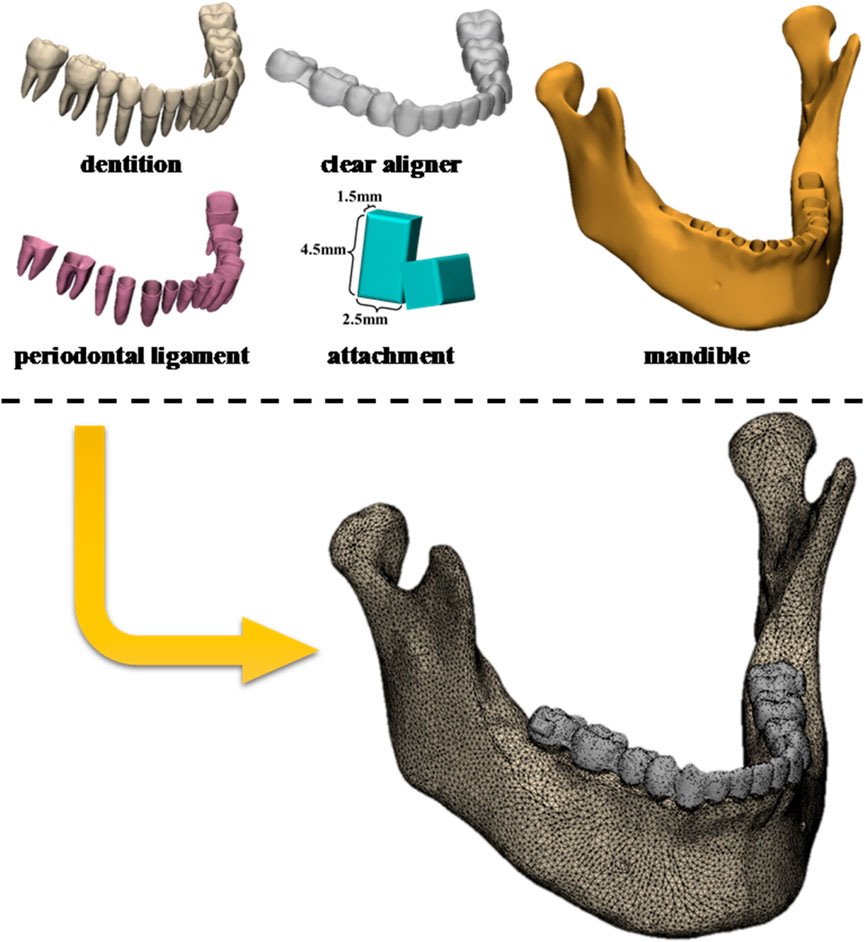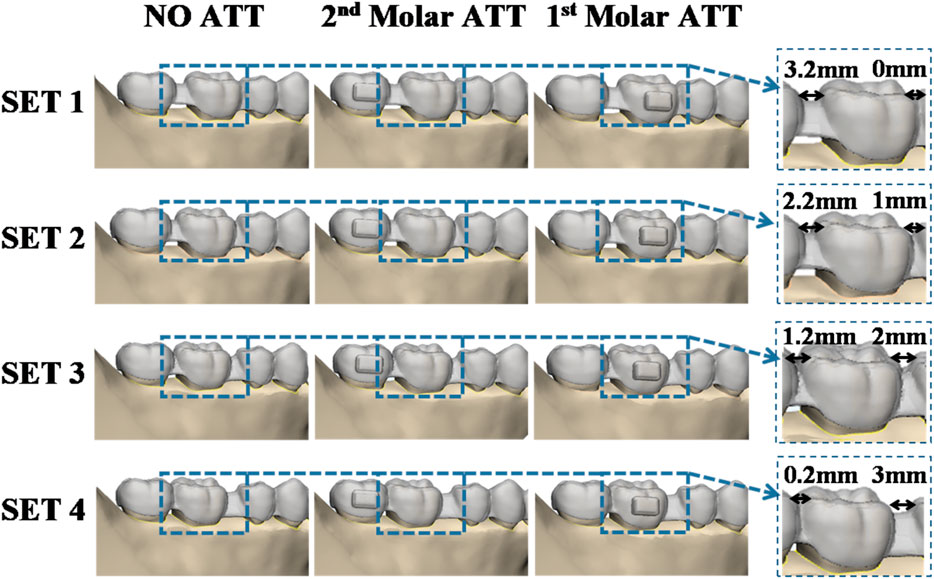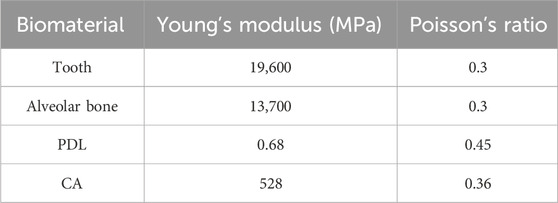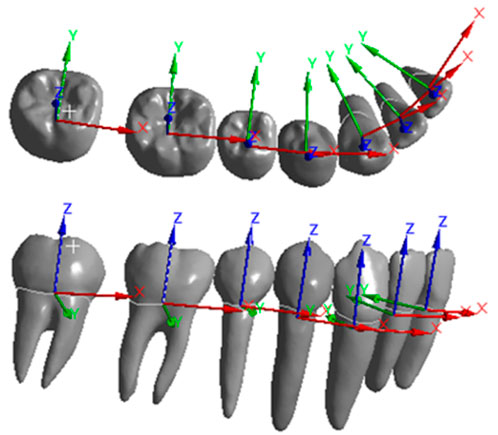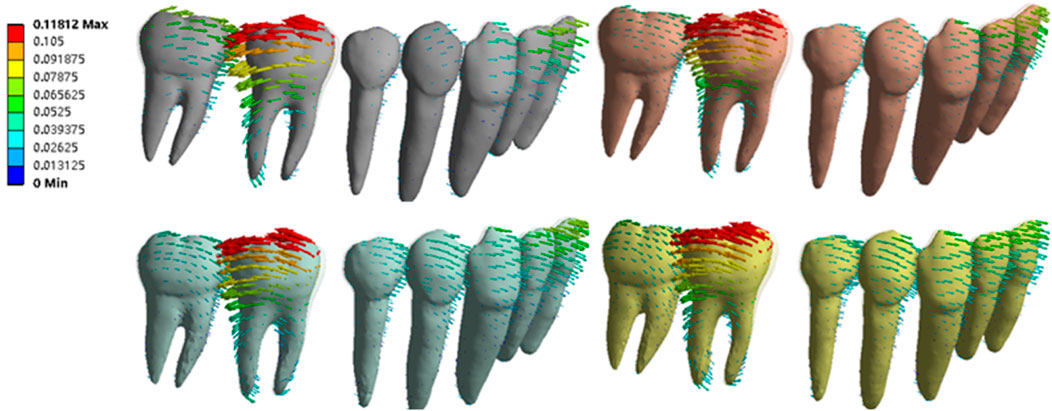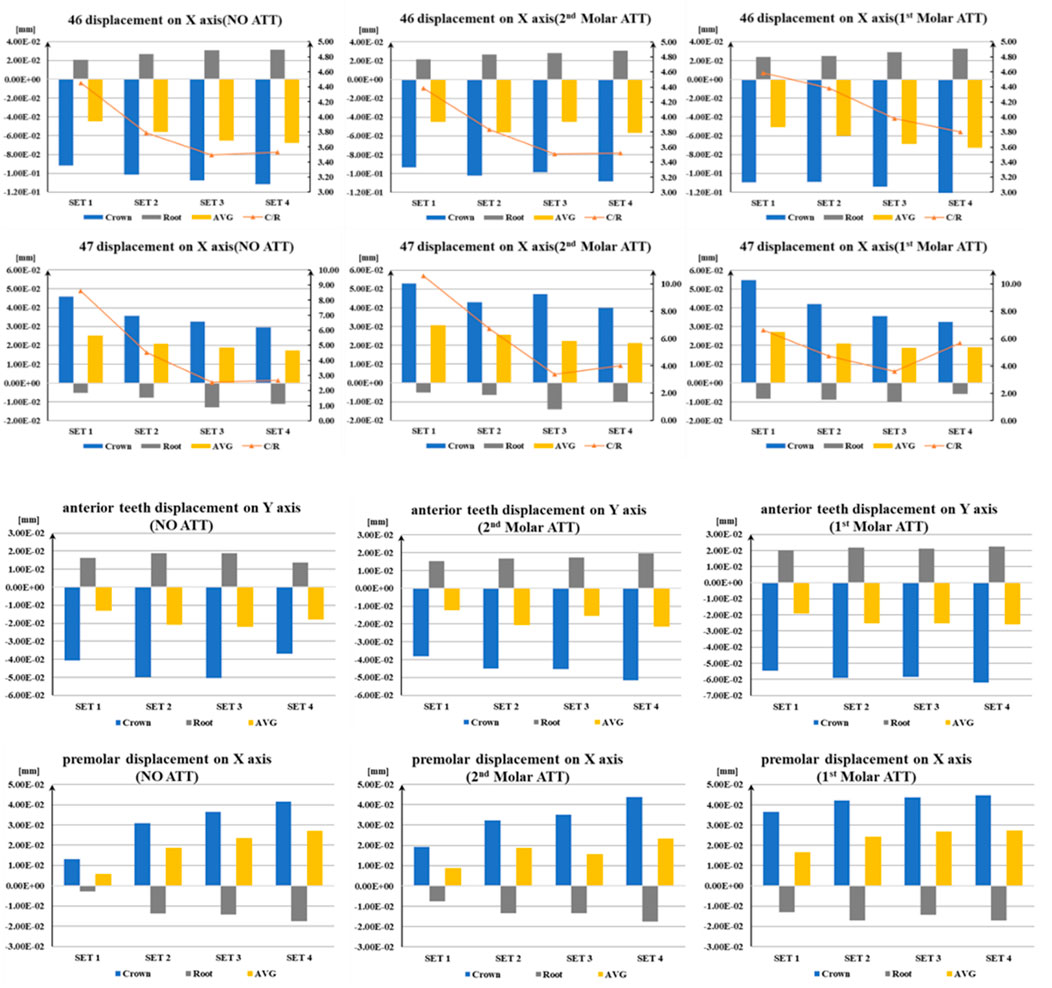- 1Hospital of Stomatology, Xi’an Jiaotong University, Xi’an, Shaanxi, China
- 2Department of Stomatology, Xi’an Jiaotong University, Xi’an, Shaanxi, China
- 3Department of Oral Anatomy and Physiology and TMD, School of Stomatology, Air Force Medical University, Xi’an, Shaanxi, China
- 4Department of Mathematics and Statistics, Xi’an Jiaotong University, Xi’an, Shaanxi, China
Introduction: This study aims to analyze the impact of varying initial positions of the mandibular first molar and attachment configurations on tooth movement by finite element analysis (FEA).
Methods: A three-dimensional (3D) model was constructed, including the mandible, dentition, periodontal ligaments (PDLs), clear aligners (CAs), and attachments. The second molar was initially positioned 3.2 mm distally. Groups were defined as follows: no attachment, attachment on the second molar (second molar ATT), and attachment on the first molar (first molar ATT). In each group, the first molar’s initial position relative to the second premolar varied (0 mm, 1 mm, 2 mm, and 3 mm). The displacement was extracted for result analysis.
Results: With distal movement of the first molar’s initial position, distal displacement of the first molar, mesial displacement of the premolars, and labial displacement of the anterior teeth increased from 9.18e−2 to 1.12e−1 mm, from 1.32e−2 to 4.16e−2 mm, and from 4.07e−2 to 4.69e−2 mm, respectively, while mesial displacement of the second molar decreased from 4.59e−2 to 2.96e−2 mm in the NO ATT group. Displacement of the first molar, premolars, and anterior teeth in the first molar ATT group was greater than that in the other groups. For the second molar, the most significant mesial displacement was observed in the second molar ATT group.
Conclusion: Without additional anchorage, the distal displacement of the first molar is concomitant with the opposite movement of other teeth in the dentition. With distal movement of the first molar’s initial position, the movement efficiency of the mandibular first molar increased. Therefore, increased step distance in precedence can be designed to enhance the overall movement efficiency.
Introduction
Mandibular molar distalization serves as a method to increase the lower arch length, thereby providing space in non-extraction treatments. In particular, for patients with mild to moderate Angle Class III malocclusion and mild crowding of the mandibular dentition without severe skeletal deformities, mandibular molar distalization is usually selected to adjust the occlusion relationship and achieve an esthetic facial profile (Park et al., 2024; Inchingolo et al., 2023; Martina et al., 2024).
There are some traditional methods available for mandibular molar distalization, but their use is often limited by patient discomfort, poor compliance (Nevant et al., 1991; Griswold et al., 2022), and tipping movement of molars (Wang et al., 2024). For example, the lip bumper relies on cooperation from patients and inevitably causes lip discomfort (Nevant et al., 1991; Griswold et al., 2022). Moreover, the lower-lingual arch appliance impedes tongue mobility and results in opposite movement of anterior teeth (Ciftci et al., 2018; Arevalo et al., 2020). Furthermore, the headgear distalizes the molar using the external traction device anchored around the neck, which is clumsy (Osvaldik-Trapl and Droschl, 1978; Altug et al., 2005). As a fixed appliance, the multi-loop edgewise arch wire, which is time-consuming for bending, can achieve only crown distalization rather than bodily movement of the molar (Wang et al., 2024; Baek et al., 2008; He et al., 2013). Considering the limitations mentioned above, novel and practical methods for molar distalization are required. With the progress of computer-aided design and manufacturing, clear aligners (CAs) were introduced and became popular for their esthetics and comfort (Weir, 2017). More importantly, the material properties of deformation and elastic rebound are key mechanical advantages that CAs leverage for molar distalization.
At present, the high efficiency of upper molar distalization by CAs has been confirmed by many studies (Robertson et al., 2020), and bodily distalization of up to 1.5 mm has been reported to have the highest predictability (88%) (Ke et al., 2019). However, the research on the distalization of mandibular molars remains scarce. The effectiveness of the entire molar distalization stage is highly dependent on the geometry of the CAs, which changes at each treatment step and directly influences distalization efficiency. Specifically, when the first molar moves distally, the CAs mesial to the first molar become longer, and those distal to the first molar become shorter. Except for the shape of the CAs, the efficiency of molar distalization is also influenced by the application of attachments. For instance, the vertical rectangular attachment can reduce mesiodistal tipping tendency during maxillary molar distalization by increasing the contact area between the CAs and the teeth (Ayidaga and Kamiloglu, 2021). The gradual worsening of attachment wear compromised the efficiency of tooth movement (Li and Yang, 2024). Given that the width of a molar crown is typically greater than its height, a horizontal rectangular attachment theoretically provides a larger contact area than a vertical attachment. In this study, the horizontal rectangular attachment was used, and the efficiency of molar distalization with different configurations was compared.
Therefore, we hypothesize that both initial positions and attachment configurations influence the mandibular molar distalization when the second molar is repositioned to its target position. The maximum and average displacement of the crown and root of all teeth in the mandibular were extracted and compared. The findings of this study will provide insights for high-efficiency mandibular molar distalization.
Materials and methods
FEA model construction
This study has been approved by the Ethics Committee of the Stomatological Hospital of Xi’an Jiaotong University (Approval No. KY-OT-20240063). A CBCT scan (Planmeca ProMax 3D, Finland) was obtained from a patient with mild Angle’s Class III malocclusion who was treated with mandibular molar distalization. The data were exported as digital imaging and communications in medicine (DICOM) files for modeling. The appropriate grayscale thresholds were set in Mimics Research software (v21.0, Materialise, Belgium) to segment the image and generate the external surfaces of the mandible and the dentition model. The 3-Matic Research software program (v13.0, Materialise, Belgium) was used for PDL, CA, and attachment modeling. The PDLs were modeled by offsetting the external surface of the roots with an average thickness of 0.2 mm. Similarly, the CAs were modeled by expanding the outer surface of the target dentition with an average thickness of 0.7 mm. The horizontal rectangular attachment (4.5 mm in width, 2.5 mm in height, and 1.5 mm in thickness) was designed and positioned on the buccal surface of the crown, as shown in Figure 1.
Grouping and material property assigning
The mandibular second molar was positioned 3.2 mm distal from the first molar, aligning with the occlusal plane defined by the buccal cusps of the mandibular molars. The models were categorized into three groups based on attachment configurations.
• No attachment (NO ATT).
• The attachment positioned on the mandibular second molar crown (second molar ATT).
• The attachment positioned on the mandibular first molar crown (first molar ATT).
For each group, the first molar was initially positioned at distances of 0 mm, 1 mm, 2 mm, and 3 mm from the second premolar, which defined the subsets SET 1, SET 2, SET 3, and SET 4, respectively. In addition, the step distance was set at 0.2 mm (as shown in Figure 2).
The meshing of all the components was conducted in 3-Matic Research software with 0.2 mm edge length for PDLs, 2 mm for teeth, CAs, and mandible. The nodes between the teeth, PDLs, and mandible were set to be shared. The process produced a total of 1,425,619 nodes and 1,164,810 elements. The resulting files were imported into ANSYS Workbench 19.2 (ANSYS, United States). All structures involved in this study were considered to be linear, elastic, isotropic, and homogeneous materials. Given that the biomechanical behavior of the alveolar bone and teeth under physiological loading approximates linear elasticity, the use of a linear elastic model is a validated approach for finite element analysis in orthodontic applications. Material parameters were derived from previous literature (Cortona et al., 2020; Hong et al., 2021; Seo et al., 2021; Liu et al., 2021; Jia et al., 2023; Ma and Li, 2021; Kang et al., 2023), as referenced in Table 1.
Boundary constraints and contact conditions
A bonding connection was established between the surfaces of roots, PDLs, and mandible and between the attachments and the crowns. A frictional condition was constructed between the crowns and CAs. The friction coefficient was set at 0.2 (20). The lower surface and condyle of the mandible were set as fixed to restrict all degrees of freedom. The “two-step method” was adopted. Specifically, the mandibular first molars were moved from the target positions back to the initial positions, and then the stress of CAs was calculated and applied to the pre-orthodontic dentition as the orthodontic force.
Coordinate system setting
As the movement patterns were similar for the corresponding teeth on the left and right sides, the local coordinate system for the right mandibular teeth was established to define the x, y, and z axes (as represented in Figure 3). The origin of the coordinate system was located at the center of the tooth. The z-axis was defined along the long axis of the tooth body. The positive z-axis direction was oriented toward the gingival side, the positive x-axis direction toward the mesial side, and the positive y-axis direction toward the lingual side.
Finite element simulation and result analysis
The maximum displacement values of the crowns and roots and the average displacement values of the teeth in mandibular dentition were extracted for result analysis. The ratios of the maximum displacement of the crowns and roots were calculated and named as C/R ratios. Furthermore, the average displacement values of premolars and anterior teeth were calculated.
Results
During the distalization of the mandibular first molar, all teeth exhibited tipping movement, and the values of the displacement were recorded, as depicted in Figure 4. The maximum displacement of the tooth crown was at the cusp or incisal edge, while that of the root was at the root apex. The first molar showed the largest tipping movement in all groups. During the distal tipping movement of the first molar, the second molar and premolar showed mesial tipping movement, and the anterior teeth exhibited labial tipping movement.
The quantitative data of tooth displacement are shown in Figure 5 (Supplementary Tables 1–12). Due to the symmetrical characteristics of both sides of the mandible arches, the right side of the mandible was selected for analysis. With the same attachment configuration, the average, crown, and root displacement of the first molar (46) increased, whereas those of the second molar (47) decreased from SET 1 to SET 4. Regarding different attachment configurations, the average displacement of the first molar in the first molar ATT group was higher than that of the NO ATT group and the second molar ATT group. The maximum average of the first molar ranged from 5.06e−2 mm (SET 1) to 7.26e−2 mm (SET4). For the minimum average displacement, it was 4.46e−2 mm and 5.58e−2 mm in SET 1 and SET 2 in the NO ATT group, respectively, and 4.51e−2 mm and 5.69e−2 mm in SET 3 and SET 4 in the second molar ATT group, respectively. The second molar reached the maximum average displacement of 3.07e−2 mm, 2.57e−2 mm, 2.23e−2 mm, and 2.12e−2 mm from SET 1 to SET 4, respectively, in the second molar ATT group. For the minimum average displacement, it was 2.51e−2 mm, 2.09e−2 mm, 1.88e−2 mm, and 1.74e−2 mm from SET 1 to SET 4, respectively, in the No ATT group. In the first molar ATT group, the displacement of the second and first molar crowns reached the maximum values at 5.48e−2 mm and 1.10e−1 mm, respectively, in SET 1, and their ratio was close to 0.5. However, in SET 4, the corresponding values were 3.25e−2 mm and 1.24e−1 mm, and the ratio decreased to 0.26.
The variation patterns in the C/R ratio were consistent among all groups except for the first molar in the first molar ATT group, decreasing from SET 1 to SET 3 and then increasing from SET 3 to SET 4. The ratio of C/R achieved minimum values in SET 3, with the corresponding values at 3.5 for the first molar and 2.5 for the second molar in the NO ATT group and 3.5 for the first molar and 3.3 for the second molar in the second molar ATT group. In the first molar ATT group, the C/R ratio of the first molar decreased from SET 1 to SET 4 and reached the minimum value at 3.8 in SET 4. The ratio of C/R achieved the maximum values in SET 1 in all groups, with values at 4.4, 4.4, and 4.6 for the first molar and 8.6, 10.1, and 6.6 for the second molar in the NO ATT group, second molar group, and first molar ATT group, respectively.
The mesial displacement of premolars and labial displacement of anterior teeth increased from SET 1 to SET 4, except for the anterior teeth in the NO ATT group, reaching the minimum value in SET 4, as shown in Figure 5. The average displacement of anterior teeth and premolars in the first molar ATT group was more than that of the other groups. Similar to the displacement variation patterns of the first molar shown in Figure 5, which increased from SET 1 to SET 4, the displacement of the anterior tooth crown (6.19e−2 mm) and premolar crown (4.48e−2 mm) reached the maximum value in SET 4 of the first molar ATT group. The labial displacement of anterior teeth was more than the mesial displacement of premolars, with the corresponding maximum values at 5.18e−2 mm of anterior teeth and 4.37e−2 mm of premolars in SET 4 of the second molar ATT group.
Discussion
The study found that the distal displacement of the first molar increased progressively during its distal movement from the initial position. Moreover, the maximal distal displacement of the first molar was achieved by placing the horizontal rectangular attachment on itself.
Finite element analysis (FEA) is an effective numerical technique used to simulate tooth movement (Vatansever et al., 2025). It was first applied in orthodontics by Takahashi et al. (1980) and has since become one of the main methods for biomechanical analysis. Although the acquisition of reliable results is predetermined by the accurate modeling and precise material properties (Fill et al., 2012; Cattaneo and Cornelis, 2021; Ding et al., 2015), a proper balance between the accuracy and simplifications of the material properties of the PDLs should be introduced without compromising the results to quickly estimate orthodontic tooth movement during treatment planning (Ahmed et al., 2023; Tang et al., 2025; Cerne and Petkovsek, 2022). In this study, a 3D finite element model of mandibular first molar distalization by CAs was constructed with the following characteristics (Park et al., 2024). It was the first study examining the distal displacement of the mandibular first molar under varying initial positions and attachment configurations (Inchingolo et al., 2023). A second-order tetrahedral element mesh was designed, exhibiting no significant distortion in the analysis outcomes (Martina et al., 2024). The stress extracted from CAs when the teeth were returned from the target positions to the initial positions was applied to the pre-orthodontic dentition and served as the orthodontic force, approximating the actual force application of the CAs.
Because the mandibular first molar is the occlusion key in mandible dentition, achieving a neutral molar occlusal relationship is essential (Murugan et al., 2024). For cases that adjust the occlusal relationship through mandibular molar distalization, the course of treatment mainly depends on the efficiency of mandibular first molar distalization, which is the lowest among all teeth in both arches (Wu et al., 2021). Therefore, to improve the overall treatment efficiency, we investigated the distalization of the mandibular first molar at varying initial positions at the same step distance (0.2 mm). The results showed that the distal movement of the first molar’s initial position increased the first molar displacement. On one hand, it can be explained by the co-action of compressed CA material mesial to the first molar and the expanded CA material distal to the first molar. When the CA was positioned on the dental arch, the deformation of the CAs mesial and distal to the first molar was the same. Hooke’s Law stated that within the elastic limit, the stress applied to a material was directly proportional to the strain it produced (Noh et al., 2024). With the same deformation (change), the original length of CAs is negatively co-related to the strain (Wang et al., 2021). Therefore, the largest stress appeared in SET 4, when the original length of CA was the shortest and the strain was the highest. From SET 1 to SET 4, the CA material distal to the first molar became shorter and played an increasingly significant role, thus leading to an increased efficiency of mandibular first molar distalization. On the other hand, this finding would make sense in orthodontic clinical practice because the limited space in the interdental gap in SET 1 weakens the compression from the mesial CA materials. Moreover, the increased contact area between the CAs and the teeth from SET 1 to SET 4 contributed to the efficiency of molar distalization. Based on these findings, an increased step distance in precedence can be designed to enhance the overall movement efficiency.
In CA treatment, attachments assist retention, enhance the application of orthodontic force, and promote the precision of tooth movement by increasing the contact area between the CAs and the teeth (AlMogbel, 2023; Putr et al., 2021). They are strategically placed on the tooth according to specific tooth movements, such as rotation, extrusion, and bodily movement. In this study, the highest efficiency of first molar horizontal distalization was achieved when the rectangular attachment was positioned on the first molar because the better grip, increased frictional force, and the couple of forces were applied to it (Ren et al., 2022). Consequently, placing a horizontal rectangular attachment on the first molar may shorten treatment time or improve predictability. The above-mentioned finding can serve as a strategy for attachment configurations in treatment design.
Considerations regarding anchorage control are revealed in this study. The stages of molar distalization showed a V-pattern, which can be either the sparse type or the intensive type. The sparse type, in which CAs distalize the molars, premolars, and incisors one by one, was selected in this study as it may theoretically cause less opposite movement of other teeth than the intensive type, in which CAs distalize several teeth simultaneously. However, the results showed that the opposite movement of other teeth was observed during molar distalization. This indicates that the application of additional anchorage, such as a mini-implant or inter-dentition Class III elastics (He et al., 2013), is required to prevent adverse effects in certain cases.
In vivo and in vitro experiments are required to investigate the effects of biological remodeling. Further validation of the results of this study necessitates exploration in the treatment design of clinical practice.
Conclusion
Without additional anchorage, the distal displacement of the first molar by CAs is concomitant with the opposite movement of other teeth in the dentition.
The maximum distal displacement of the first molar crown can be achieved by placing a horizontal rectangular attachment on itself.
With the distal movement of the first molar’s initial position, the movement efficiency of the mandibular first molar was increased. Therefore, increased step distance in precedence can be designed to enhance the overall movement efficiency.
Limitations
Although finite element analysis offers numerous benefits, it is essential to be aware of its limitations to ensure proper application. First, all the results were based on simplified assumptions; for instance, the simplified PDL properties may not fully capture the actual characteristics of the system. Moreover, the lack of biological remodeling may affect the reliability of the results.
Data availability statement
The original contributions presented in the study are included in the article/supplementary material; further inquiries can be directed to the corresponding authors.
Ethics statement
The studies involving human participants were reviewed and approved by Stomatological Hospital of Xi’an Jiaotong University (KY-QT-20240063). The studies were conducted in accordance with the local legislation and institutional requirements. The participants provided their written informed consent to participate in this study.
Author contributions
FK: Conceptualization, Data curation, Formal analysis, Investigation, Methodology, Software, Writing – original draft. YX: Investigation, Writing – review and editing, Data curation, Methodology. XZ: Investigation, Software, Writing – review and editing. ZL: Conceptualization, Investigation, Methodology, Software, Supervision, Writing – review and editing. DL: Writing – review and editing, Conceptualization, Investigation. JZ: Resources, Validation, Writing – review and editing, Software. YL: Data curation, Formal Analysis, Writing – review and editing. ML: Methodology, Resources, Supervision, Validation, Writing – review and editing. KQ: Funding acquisition, Methodology, Project administration, Supervision, Writing – review and editing.
Funding
The authors declare that financial support was received for the research and/or publication of this article. This work was supported and funded by the Xi’an Science and Technology Plan Project (2023JH-YXYB-0211).
Conflict of interest
The authors declare that the research was conducted in the absence of any commercial or financial relationships that could be construed as a potential conflict of interest.
Generative AI statement
The authors declare that no Generative AI was used in the creation of this manuscript.
Any alternative text (alt text) provided alongside figures in this article has been generated by Frontiers with the support of artificial intelligence and reasonable efforts have been made to ensure accuracy, including review by the authors wherever possible. If you identify any issues, please contact us.
Publisher’s note
All claims expressed in this article are solely those of the authors and do not necessarily represent those of their affiliated organizations, or those of the publisher, the editors and the reviewers. Any product that may be evaluated in this article, or claim that may be made by its manufacturer, is not guaranteed or endorsed by the publisher.
Supplementary material
The Supplementary Material for this article can be found online at: https://www.frontiersin.org/articles/fbioe.2025.1665588/full#supplementary-material
References
Ahmed, T., Padmanabhan, S., and Sathyanarayana, H. P. (2023). Effects of varying attachment positions on palatal displacement of maxillary incisors with clear aligner therapy: a three-dimensional finite element analysis. J. Orofac. Orthop. 84 (3), 178–188. doi:10.1007/s00056-021-00374-3
AlMogbel, A. (2023). Clear aligner therapy: up to date review article. J. Orthod. Sci. 12, 37. doi:10.4103/jos.jos_30_23
Altug, H., Bengi, A. O., Akin, E., and Karacay, S. (2005). Dentofacial effects of asymmetric headgear and cervical headgear with removable plate on unilateral molar distalization. Angle Orthod. 75 (4), 584–592. doi:10.1043/0003-3219(2005)75[584:DEOAHA]2.0.CO;2
Arevalo, S. S., Choy, R., Rich, A. P., Felemban, O., Bagher, S. M., and Loo, C. Y. (2020). Relationship of lower lingual arch appliance use and impaction of second molars: a retrospective study. Pediatr. Dent. 42 (2), 123–125. Available online at: https://www.ingentaconnect.com/content/aapd/pd/2020/00000042/00000002/art00007
Ayidaga, C., and Kamiloglu, B. (2021). Effects of variable composite attachment shapes in controlling upper molar distalization with aligners: a nonlinear finite element study. J. Healthc. Eng. 2021, 5557483. doi:10.1155/2021/5557483
Baek, S. H., Shin, S. J., Ahn, S. J., and Chang, Y. I. (2008). Initial effect of multiloop edgewise archwire on the mandibular dentition in class III malocclusion subjects. a three-dimensional finite element study. Eur. J. Orthod. 30 (1), 10–15. doi:10.1093/ejo/cjm098
Cattaneo, P. M., and Cornelis, M. A. (2021). Orthodontic tooth movement studied by finite element analysis: an update. what can we learn from these simulations? Curr. Osteoporos. Rep. 19 (2), 175–181. doi:10.1007/s11914-021-00664-0
Cerne, B., and Petkovsek, M. (2022). High-speed camera-based optical measurement methods for in-mesh tooth deflection analysis of thermoplastic spur gears. Mater. Des. 223, 111184. doi:10.1016/j.matdes.2022.111184
Ciftci, V., Uzel, A., and Dogan, M. C. (2018). Evaluation of skeletal and dental effects of lower lingual arches. J. Clin. Pediatr. Dent. 42 (6), 469–474. doi:10.17796/1053-4625-42.6.13
Cortona, A., Rossini, G., Parrini, S., Deregibus, A., and Castroflorio, T. (2020). Clear aligner orthodontic therapy of rotated mandibular round-shaped teeth: a finite element study. Angle Orthod. 90 (2), 247–254. doi:10.2319/020719-86.1
Ding, X., Liao, S. H., Zhu, X. H., Wang, H. M., and Zou, B. J. (2015). Effect of orthotropic material on finite element modeling of completely dentate mandible. Mater. Des. 84, 144–153. doi:10.1016/j.matdes.2015.06.091
Fill, T. S., Toogood, R. W., Major, P. W., and Carey, J. P. (2012). Analytically determined mechanical properties of, and models for the periodontal ligament: critical review of literature. J. Biomechanics 45 (1), 9–16. doi:10.1016/j.jbiomech.2011.09.020
Griswold, O., Li, C., Orr, J. C., Boucher, N. S., Shah, S. R., and Chung, C. H. (2022). Lip bumper therapy does not influence the sagittal mandibular incisor position in a retrospective CBCT study. J. Clin. Med. 11 (20), 6032. doi:10.3390/jcm11206032
He, S., Gao, J., Wamalwa, P., Wang, Y., Zou, S., and Chen, S. (2013). Camouflage treatment of skeletal class III malocclusion with multiloop edgewise arch wire and modified class III elastics by maxillary mini-implant anchorage. Angle Orthod. 83 (4), 630–640. doi:10.2319/091312-730.1
Hong, K., Kim, W. H., Eghan-Acquah, E., Lee, J. H., Lee, B. K., and Kim, B. (2021). Efficient design of a clear aligner attachment to induce bodily tooth movement in orthodontic treatment using finite element analysis. Materials 14 (17), 4926. doi:10.3390/ma14174926
Inchingolo, A. M., Inchingolo, A. D., Carpentiere, V., Del Vecchio, G., Ferrante, L., Di Noia, A., et al. (2023). Predictability of dental distalization with clear aligners: a systematic review. Bioengineering 10 (12), 1390. doi:10.3390/bioengineering10121390
Jia, L., Wang, C., Li, L., He, Y., Wang, C., Song, J., et al. (2023). The effects of lingual buttons, precision cuts, and patient-specific attachments during maxillary molar distalization with clear aligners: comparison of finite element analysis. Am. J. Orthod. Dentofac. Orthop. 163 (1), e1–e12. doi:10.1016/j.ajodo.2022.10.010
Kang, F., Wu, Y., Cui, Y., Yuan, J., Hu, Z., and Zhu, X. (2023). The displacement of teeth and stress distribution on periodontal ligament under different upper incisors proclination with clear aligner in cases of extraction: a finite element study. Prog. Orthod. 24 (1), 38. doi:10.1186/s40510-023-00491-2
Ke, Y., Zhu, Y., and Zhu, M. (2019). A comparison of treatment effectiveness between clear aligner and fixed appliance therapies. BMC Oral Health 19 (1), 24. doi:10.1186/s12903-018-0695-z
Li, Q., and Yang, K. (2024). Surface wear of attachments in patients during clear aligner therapy: a prospective clinical study. Prog. Orthod. 25 (1), 7. doi:10.1186/s40510-023-00506-y
Liu, L., Zhan, Q., Zhou, J., Kuang, Q., Yan, X., Zhang, X., et al. (2021). Effectiveness of an anterior mini-screw in achieving incisor intrusion and palatal root torque for anterior retraction with clear aligners. Angle Orthod. 91 (6), 794–803. doi:10.2319/120420-982.1
Ma, Y., and Li, S. (2021). The optimal orthodontic displacement of clear aligner for mild, moderate and severe periodontal conditions: an in vitro study in a periodontally compromised individual using the finite element model. BMC Oral Health 21 (1), 109. doi:10.1186/s12903-021-01474-7
Martina, H., Adriana, A. S., Ernesto, B., Alessandra, I., Roberto, A. V., and Gabriella, G. (2024). Lower molar distalization using clear aligners: is it effective? a systematic review. J. Orthod. Sci. 13, 11. doi:10.4103/jos.jos_174_23
Murugan, S. M., Kailasam, V., Rao, G. U., Krithika, C., Kirthiga, M., Aarthi, J., et al. (2024). Changes in andrews' fifth key of occlusion (interproximal contacts) before and after orthodontic treatment. J. Clin. Pediatr. Dent. 48 (4), 86–98. doi:10.22514/jocpd.2024.082
Nevant, C. T., Buschang, P. H., Alexander, R. G., and Steffen, J. M. (1991). Lip bumper therapy for gaining arch length. Am. J. Orthod. Dentofac. Orthop. 100 (4), 330–336. doi:10.1016/0889-5406(91)70070-d
Noh, H. K., Park, C. S., Kim, H. J., and Park, H. S. (2024). Is Hooke's law applicable to an orthodontic cantilever? Am. J. Orthod. Dentofac. Orthop. 166 (5), 458–468.e1. doi:10.1016/j.ajodo.2024.06.018
Osvaldik-Trapl, M., and Droschl, H. (1978). Upper headgear versus lower headgear, yokes, and class III elastics. Angle Orthod. 48 (1), 57–61. doi:10.1043/0003-3219(1978)048<0057:UHVLHY>2.0.CO;2
Park, T. H., Shen, C., Chung, C. H., and Li, C. (2024). Vertical control in molar distalization by clear aligners: a systematic review and meta-analysis. J. Clin. Med. 13 (10), 2845. doi:10.3390/jcm13102845
Putrino, A., Barbato, E., and Galluccio, G. (2021). Clear aligners: between evolution and efficiency-A scoping review. Int. J. Environ. Res. Public Health 18 (6), 2870. doi:10.3390/ijerph18062870
Ren, L., Liu, L., Wu, Z., Shan, D., Pu, L., Gao, Y., et al. (2022). The predictability of orthodontic tooth movements through clear aligner among first-premolar extraction patients: a multivariate analysis. Prog. Orthod. 23 (1), 52. doi:10.1186/s40510-022-00447-y
Robertson, L., Kaur, H., Fagundes, N. C. F., Romanyk, D., Major, P., and Flores Mir, C. (2020). Effectiveness of clear aligner therapy for orthodontic treatment: a systematic review. Orthod. Craniofacial Res. 23 (2), 133–142. doi:10.1111/ocr.12353
Seo, J. H., Eghan-Acquah, E., Kim, M. S., Lee, J. H., Jeong, Y. H., Jung, T. G., et al. (2021). Comparative analysis of stress in the periodontal ligament and center of rotation in the tooth after orthodontic treatment depending on clear aligner thickness-finite element analysis study. Materials 14 (2), 324. doi:10.3390/ma14020324
Takahashi, N., Kitagami, T., and Komori, T. (1980). Behaviour of teeth under various loading conditions with finite element method. J. Oral Rehabilitation 7 (6), 453–461. doi:10.1111/j.1365-2842.1980.tb00464.x
Tang, X. Y., Zhang, L., Jiang, T., Su, H., Chen, J. Y., Qin, Y. Q., et al. (2025). Upper incisal torque movement with clear aligners: a three-dimensional finite element analysis. J. World Fed. Orthod. 14 (4), 227–234. doi:10.1016/j.ejwf.2025.04.002
Vatansever, R., Gurel, H. G., and Koc, O. (2025). Biomechanical effects of attachment designs in maxillary first molar mesialization with clear aligners: a finite element study. Prog. Orthod. 26, 32. doi:10.1186/s40510-025-00578-y
Wang, J., Li, M., Jiang, Y., Yu, K., Hartland, G. V., and Wang, G. P. (2021). Polymer dependent acoustic mode coupling and Hooke's law spring constants in stacked gold nanoplates. J. Chem. Phys. 155 (14), 144701. doi:10.1063/5.0066661
Wang, Y., Zhou, S., Zheng, J., Yan, L., Ngan, P., Hua, F., et al. (2024). Comparison of treatment effects between clear aligners and fixed appliances in patients treated with miniscrew-assisted molar distalization. Eur. J. Orthod. 46 (3), cjae021. doi:10.1093/ejo/cjae021
Weir, T. (2017). Clear aligners in orthodontic treatment. Aust. Dent. J. 62 (Suppl. 1), 58–62. doi:10.1111/adj.12480
Keywords: clear aligner, tooth movement, molar distalization, finite element analysis, orthodontics
Citation: Kang F, Xu Y, Zhao X, Lu Z, Li D, Zhao J, Li Y, Li M and Qi K (2025) Distalization of the mandibular first molar with clear aligners: a 3D finite element study. Front. Bioeng. Biotechnol. 13:1665588. doi: 10.3389/fbioe.2025.1665588
Received: 14 July 2025; Accepted: 21 October 2025;
Published: 13 November 2025.
Edited by:
Vincenzo Grassia, University of Campania Luigi Vanvitelli, ItalyReviewed by:
Adriana Fiori, University of Campania Luigi Vanvitelli, ItalyMaría Elena De Felice, University of L'Aquila, Italy
Copyright © 2025 Kang, Xu, Zhao, Lu, Li, Zhao, Li, Li and Qi. This is an open-access article distributed under the terms of the Creative Commons Attribution License (CC BY). The use, distribution or reproduction in other forums is permitted, provided the original author(s) and the copyright owner(s) are credited and that the original publication in this journal is cited, in accordance with accepted academic practice. No use, distribution or reproduction is permitted which does not comply with these terms.
*Correspondence: Kun Qi, MzM3MDg5ODBAcXEuY29t; Menghong Li, bGltZW5naG9uZ0B4anR1LmVkdS5jbg==
†These authors have contributed equally to this work
 Fujia Kang
Fujia Kang Yifei Xu3†
Yifei Xu3† Menghong Li
Menghong Li